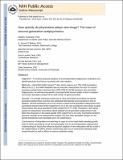How Quickly Do Physicians Adopt New Drugs? The Case of Second-Generation Antipsychotics
Author(s)
Huskamp, Haiden A.; O'Malley, A. James; Horvitz-Lennon, Marcela; Taub, Anna Levine; Berndt, Ernst R.; Donohue, Julie M.; ... Show more Show less
DownloadBerndt_How quickly.pdf (76.00Kb)
OPEN_ACCESS_POLICY
Open Access Policy
Creative Commons Attribution-Noncommercial-Share Alike
Terms of use
Metadata
Show full item recordAbstract
Objective The authors examined physician adoption of second-generation antipsychotic medications and identified physician-level factors associated with early adoption.
Methods The authors estimated Cox proportional-hazards models of time to adoption of nine second-generation antipsychotics by 30,369 physicians who prescribed antipsychotics between 1996 and 2008, when the drugs were first introduced, and analyzed the total number of agents prescribed during that time. The models were adjusted for physicians’ specialty, demographic characteristics, education and training, practice setting, and prescribing volume. Data were from IMS Xponent, which captures over 70% of all prescriptions filled in the United States, and the American Medical Association Physician Masterfile.
Results On average, physicians waited two or more years before prescribing new second-generation antipsychotics, but there was substantial heterogeneity across products in time to adoption. General practitioners were much slower than psychiatrists to adopt second-generation antipsychotics (hazard ratios (HRs) range .10−.35), and solo practitioners were slower than group practitioners to adopt most products (HR range .77−.89). Physicians with the highest antipsychotic-prescribing volume adopted second-generation antipsychotics much faster than physicians with the lowest volume (HR range .15−.39). Psychiatrists tended to prescribe a broader set of antipsychotics (median=6) than general practitioners and neurologists (median=2) and pediatricians (median=1).
Conclusions As policy makers search for ways to control rapid health spending growth, understanding the factors that influence physician adoption of new medications will be crucial in the efforts to maximize the value of care received by individuals with mental disorders as well as to improve medication safety.
Date issued
2013-04Department
Sloan School of ManagementJournal
Psychiatric Services
Publisher
American Psychiatric Association
Citation
Huskamp, Haiden A., A. James O’Malley, Marcela Horvitz-Lennon, Anna Levine Taub, Ernst R. Berndt, and Julie M. Donohue. “How Quickly Do Physicians Adopt New Drugs? The Case of Second-Generation Antipsychotics.” Psychiatric Services 64, no. 4 (April 1, 2013): 324.
Version: Author's final manuscript
ISSN
1075-2730